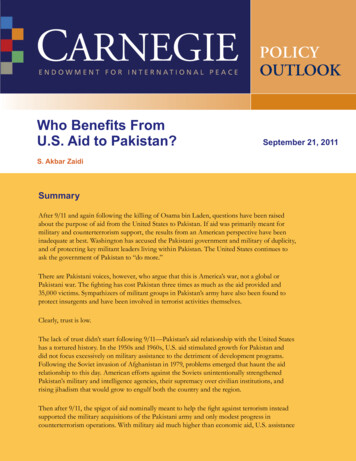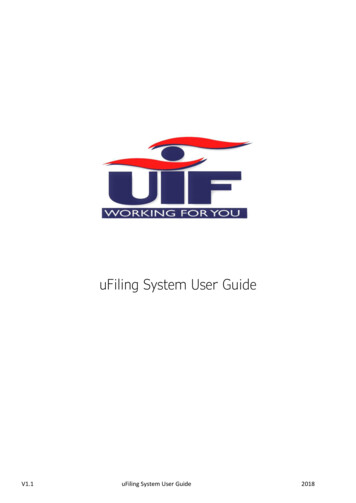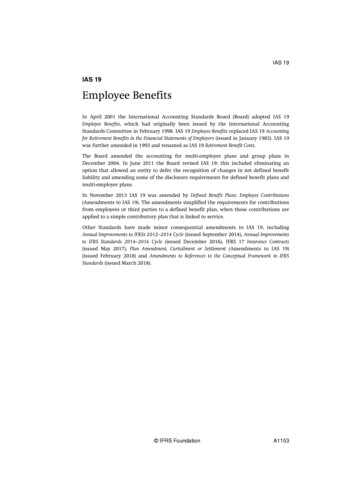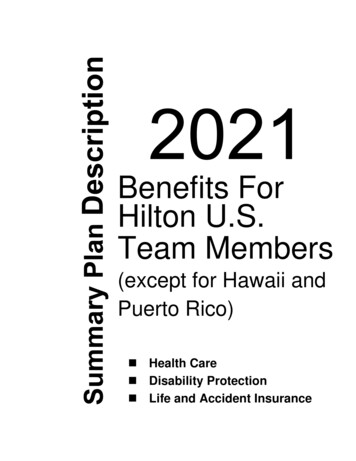
Transcription
Who Benefits FromU.S. Aid to Pakistan?September 21, 2011S. Akbar ZaidiSummaryAfter 9/11 and again following the killing of Osama bin Laden, questions have been raisedabout the purpose of aid from the United States to Pakistan. If aid was primarily meant formilitary and counterterrorism support, the results from an American perspective have beeninadequate at best. Washington has accused the Pakistani government and military of duplicity,and of protecting key militant leaders living within Pakistan. The United States continues toask the government of Pakistan to “do more.”There are Pakistani voices, however, who argue that this is America’s war, not a global orPakistani war. The fighting has cost Pakistan three times as much as the aid provided and35,000 victims. Sympathizers of militant groups in Pakistan’s army have also been found toprotect insurgents and have been involved in terrorist activities themselves.Clearly, trust is low.The lack of trust didn’t start following 9/11—Pakistan’s aid relationship with the United Stateshas a tortured history. In the 1950s and 1960s, U.S. aid stimulated growth for Pakistan anddid not focus excessively on military assistance to the detriment of development programs.Following the Soviet invasion of Afghanistan in 1979, problems emerged that haunt the aidrelationship to this day. American efforts against the Soviets unintentionally strengthenedPakistan’s military and intelligence agencies, their supremacy over civilian institutions, andrising jihadism that would grow to engulf both the country and the region.Then after 9/11, the spigot of aid nominally meant to help the fight against terrorism insteadsupported the military acquisitions of the Pakistani army and only modest progress incounterterrorism operations. With military aid much higher than economic aid, U.S. assistance
has strengthened the hand of Pakistan’s military in the country’s political economy and failed tosupport the civilian government and democratic institutions.But changes in the U.S. and Pakistani administrations in 2008 shifted aid toward development.Perhaps a longer-term engagement and commitment to civilian and development aid mightresult in strengthening democracy in Pakistan instead of reinforcing the military dominance thatthwarts U.S. counterterrorism goals. This shift can illuminate how American aid to Pakistan canaddress both U.S. and Pakistani objectives and concerns.It has become increasingly clear since the killing of Osama bin Laden thatU.S. government aid to Pakistan is plagued by a complexity that belies claimsof a strategic partnership. Bilateral assistance ordinarily should be a win-winproposition for both countries, in this case with the United States helpingPakistan to address American security concerns, and Pakistan receiving muchneeded funding to serve its population, meet perennial and ever-increasingrevenue shortfalls, and help modernize its military forces. In reality, the aidrelationship between the United States and Pakistan has been muddled, deceptive,complicated, and even dangerous, especially since the events of September 11,2001. The barrage of writing and analysis that has appeared since the killing ofbin Laden in Pakistan has underscored this point, with such words as “duplicity”and “double game” being used extensively by U.S. analysts and policymakers alike.It would be in the interest of the United States to ensure a stable Pakistan, with aliberal, democratic government focused on development. One could reasonablyexpect that the civilian government of Pakistan has similar objectives. However,the relationship has been so fraught with cross-purposes and doublespeak thatthe real purpose of U.S. aid to Pakistan in the post-9/11 era is no longer clear—from either country’s perspective. Of course, the United States wants Pakistanto prosecute the war on terrorism and help defeat al-Qaeda and the Talibaninsurgency in Afghanistan as well as in Pakistan. It also wants to help Pakistandevelop into a stable, democratic state at peace with itself and its neighbors. Butuntil recently the primary recipient of U.S. aid in Pakistan was the military andits Inter-Services Intelligence Directorate (ISI). U.S. cooperation, therefore, hasstrengthened the very actors—the Pakistani security establishment—that haveserved the interests of neither Pakistan nor the United States. It is time thatpolicymakers in both countries rethink how this relationship should proceed.2It would be inthe interestof the UnitedStates toensure a stablePakistan,with a liberal,democraticgovernmentfocused ondevelopment.
Five Decades of Aid to Pakistan, 1950‒2001From Independence to the Soviet Invasion of AfghanistanIt is not much of an exaggeration to state that since independence in 1947,Pakistan has been an aid-dependent nation. Some estimates suggest that the grossdisbursement of overseas development assistance to Pakistan from 1960 to 2002(in 2001 prices) was 73.1 billion, from both bilateral and multilateral sources.1Almost 30 percent of this official development assistance came in the form ofbilateral aid from the United States, the largest single bilateral donor by far.2Assistance of this magnitude was made possible by the fact that Pakistan’sleadership, especially its military leadership, clearly aligned itself with the UnitedStates during the Cold War. By joining SEATO (the Southeast Asia TreatyOrganization) and CENTO (the Central Treaty Organization) and signingmilitary and other pacts of cooperation with the United States in the 1950sand 1960s, Pakistan hoped to benefit from U.S. geopolitical support as well asfinancial and military assistance. The United States, in turn, viewed Pakistan asan ally and a hedge against perceived Soviet expansionism in the region.American aid to Pakistan was vital during the 1960s. It helped play a significantpart in numerous development projects, food support, and humanitarianassistance through the United States Agency for International Development(USAID) and other mechanisms.3 Thanks to this assistance, the United Stateswas well-received by the people of Pakistan. By 1964, overall aid and assistanceto Pakistan was around 5 percent of its GDP and was arguably critical inspurring Pakistani industrialization and development, with GDP growth ratesrising to as much as 7 percent per annum.4 Though the United States decided tocut off most aid to Pakistan when Pakistan initiated the 1965 war with India overKashmir, aid resumed after a few years, albeit at much lower levels.Not only was aid vital in the 1960s, but it also was focused on civilian economicassistance. After a brief spike in the late 1950s, American military assistance andreimbursements in the 1960s were consistently below the total aid provided byUSAID’s predecessors and total economic assistance provided to Pakistan inthose years.5 This balance may have contributed to the positive impact U.S. aidhad until its termination after the second Kashmir war.From the Soviet Invasion to 9/11The Soviet invasion of Afghanistan in 1979 again precipitated increased U.S.development and military assistance as Pakistan became a frontline state in the3
war against Soviet occupation. Large and undisclosed amounts of money andarms were channeled to the mujahideen fighting the Red Army in Afghanistanthrough Pakistan’s military and its clandestine agencies, particularly the ISI. Whilethis “aid” was not meant directly for Pakistan’s military, there is ample evidencethat significant funds meant for the Afghan mujahideen were pocketed by Pakistaniofficers.6 Pakistan also received money directly to provide for the rehabilitationof Afghan refugees and for the development of roads and communicationsinfrastructure. Despite these funds, America’s image in Pakistan had begun todecay by the 1980s because of the distrust among Pakistanis following America’sfailure to come to its assistance during the 1971 war with India, the perceivedU.S. emphasis on fighting the Soviets rather than helping Pakistan, the growingIslamization of Pakistani society under Muhammad Zia ul-Haq, and the rise ofpolitical Islam after the 1979 Iranian Revolution.The unprecedented increase in aid during the Soviet invasion of Afghanistan wasreversed when President George H. W. Bush could no longer certify that Pakistandid not possess nuclear weapons in 1989 as required by the Pressler Amendment.Consequently, U.S. development assistance fell from 452 million in 1989 to 1percent of that in 1998 on account of the sanctions imposed by the United States.On balance, U.S. assistance prior to 2001 neither put Pakistan on a path to selfsustaining growth nor recovered real value in terms of America’s own Cold Warobjectives. Certainly, the expulsion of the Soviet Union from Afghanistan withstrategic help from Pakistan was a major gain for Washington, but the Afghancampaign also ended up strengthening the praetorian state in Pakistan whiledoing little to aid its people, even as the stage was set for developments thatwould lead to the terrorist attacks of September 2001.The events of September 11 would dramatically complete the change in thenature of U.S. aid to Pakistan from developmental aid, which dominated duringthe 1950s and 1960s, to purchasing Pakistan’s cooperation in counterterrorism.While aid in the earlier decades focused on helping the people of Pakistan and insupporting economic growth, aid in the 1980s in particular began to strengthenthe military and its clandestine institutions. Aid, which was largely productive inthe earliest phase, thus gave rise to more damaging consequences in later years.Moreover, developmental aid and “war aid” were very different categories ofsupport, producing very different results. The war aid disbursed to Pakistan’smilitary, the ISI, and the Afghan mujahideen — although intended to serveAmerica’s purposes more than Pakistan’s—ironically nurtured the very entitiesthat were to cause serious problems three decades later.4
The Complicated Issues of U.S. Aid, 2001‒20109/11 and Military-Centric AidTable 1 shows that in FY 2002–2010 (and not including commitments such asthe Enhanced Partnership with Pakistan Act of 2009), the United States gavePakistan almost 19 billion, or more than 2 billion on average each year, withtwice as much allocated in 2010 ( 3.6 billion) than in 2007. Over the periodof 2002–2008, only 10 percent of this money “was explicitly for Pakistanidevelopment,” and as much as “75 percent of the money was explicitly formilitary purposes.” In more recent years the share of economic-related aid hasrisen, but it is still less than half.7The United States has considered Pakistan an essential ally in the war onterrorism since 2001 and as part of its broader strategy has solicited Pakistanimilitary operations in support of various counterterrorism operations. Tocompensate Pakistan’s military, the United States created the Coalition SupportFund (CSF), “designed to support only the costs of fighting terrorism overand above regular military costs incurred by Pakistan. Nearly two-thirds—60percent—of the money that the United States gave Pakistan was part of theCSF.”8 According to Robert Gates, the secretary of defense at the time, CSFfunds have been used to support approximately 90 Pakistani army operationsand keep around 100,000 Pakistani soldiers in the field in the northwest of thecountry close to the Afghan border.9Since 2009, a new category of security-related aid, the Pakistan CounterinsurgencyFund/Counterinsurgency Capability Fund (PCF/PCCF), has also been developed.The PCF/PCCF objectives are similar to those of the CSF, though with perhapsmore focus on fighting insurgency within Pakistan, such as the Pakistan military’sSwat campaigns in 2009. This clearly is in both countries’ interests, and opinionpolls show public support in Pakistan for combating violent extremists.Unlike military aid, economic-related U.S. aid to Pakistan had been a muchlower share of total aid until 2009. The primary purpose of aid to Pakistanhas been counterterrorism, not economic support, the building of schools andhospitals, or development, broadly defined. Twenty-five percent of total aidbetween 2001 and 2008 was allocated for economic and development assistance,including food aid. Some 5.8 billion of U.S. aid was spent in FATA (theFederally Administered Tribal Areas), the focus of most counterterrorism andcounterinsurgency activity in Pakistan. Ninety-six percent of those funds weredirected toward military operations, and only 1 percent toward development.105
Table 1. Direct Overt U.S. Aid and MilitaryReimbursements to Pakistan, FY 2002–FY 2011(rounded to the nearest million dollars)Program or AccountFY 2002–FY 2004FY2006FY2006FY2007FY2008FY 206——281456114f212fCN—82449544743 f225f3,121 c9648627311,019685 g756 g8,138 gg————7525—100—375299297297298300288 i2,1542963222225184INCLE1543238242288170 4007001,1001,2003,6691,3131,2601,1271,5361,674 389530——286—1,003 d298337394 e3471,1141,292 Total Economic-Related1,2243885395765071,365 h1,5956,0381,389Grand Total4,8931,7011,7991,7032,0433,039h3,578 i18,7563,054CSF aFCFMFIMETTotal Security-RelatedESFFood Aid bHRDFPrepared for the Congressional Research Service by K. Alan Kronstadt, specialist in South Asian Affairs, September 2,2010.Sources: U.S. Departments of State, Defense, and Agriculture; U.S. Agency for International Section 1206 of the National Defense AuthorizationAct (NDAA) for FY 2006 (P.L. 109–163, global trainand equip)Counternarcotics Funds (Pentagon budget)Coalition Support Funds (Pentagon budget)Child Survival and Health (Global Health and ChildSurvival, or GHCS, from FY 2010)Development AssistanceEconomic Support FundsSection 1206 of the NDAA for FY 2008 (P.L. 110–181,Pakistan Frontier Corps train and equip)Foreign Military FinancingHuman Rights and Democracy Funds6IDAIMETINCLEMRANADRPCF/PCCFInternational Disaster Assistance (Pakistaniearthquake and internally displaced persons relief)International Military Education and TrainingInternational Narcotics Control and Law Enforcement(includes border security)Migration and Refugee AssistanceNon-proliferation, Anti-terrorism, Demining, andRelated (the majority allocated for Pakistan is forantiterrorism assistance)Pakistan Counterinsurgency Fund/Counterinsurgency Capability Fund (transferred toState Department oversight in FY 2010)
Notesa.CSF is Pentagon funding to reimburse Pakistan for itssupport of U.S. military operations. It is not officiallydesignated as foreign assistance.b.P.L.480 Title I (loans), P.L.480 Title II (grants), and Section416(b) of the Agricultural Act of 1949, as amended (surplusagricultural commodity donations). Food aid totals do notinclude freight costs, and total allocations are unavailableuntil the fiscal year’s end.c.Includes 220 million for FY 2002 PeacekeepingOperations reported by the State Department.d.Congress authorized Pakistan to use the FY 2003 and FY2004 ESF allocations to cancel a total of about 1.5 billionin concessional debt to the U.S. government.e.Includes 110 million in Pentagon funds transferred to theState Department for projects in Pakistan’s tribal areas (P.L.110–28).f.This funding is “requirements-based”; there are no preallocation data.g.Congress appropriated 1.2 billion for FY 2009 and 1.57billion for FY 2010, and the administration requested 2billion for FY 2011, in additional CSF for all U.S. coalitionpartners. In the past, Pakistan has received more thanthree-quarters of such funds. FY 2009–FY 2011 may thusinclude billions of dollars in additional CSF payments toPakistan.h.Includes a “bridge” ESF appropriation of 150 million (P.L.110–252), 15 million of which was later transferred toINCLE. Also includes FY 2009 supplemental appropriationsof 539 million for ESF, 66 million for INCLE, 40 millionfor MRA, and 2 million for NADR.i.The FY 2010 estimate includes supplementalappropriations of 259 million for ESF, 40 million forINCLE, and 50 million for FMF funds for Pakistan, as wellas ongoing disaster relief in the food aid and IDA accounts.Not only was economic aid heavily overshadowed by military and securityrelated aid, but until recently it was even lower than economic aid providedby other multilateral and bilateral donors. The funds that were provided weredesignated for primary education, literacy programs, basic health, food aid, andsupport for democracy, governance, and elections, with almost all of the fundsgoing through and disbursed by USAID. Some cash transfers were also madeavailable to the Pakistani government, but it was not “obliged to account for howthis type of aid is spent,” and the “U.S. government has traditionally given thesefunds to the Pakistani government without strings attached.”11The United States has only recently begun to implement a longer-termstrategy focusing on Pakistan’s frontier regions for the tribal areas’ sustainabledevelopment. However, for numerous obvious reasons, any development strategyin the frontier areas will continue to face insurmountable problems, especiallyregarding implementation and oversight. The frontier regions are not the mosthospitable terrain at the best of times, and with a war taking place in the region,most American development efforts will be compromised. The Pakistanigovernment, unfortunately, has been unwilling to do all it can to develop FATAor even the rest of Pakistan, and increase the effectiveness of American aid.7
The Pakistani establishment does not see the war against extremists who targetAfghanistan and the United States as its fight, and in the end it is the Pakistaniestablishment, primarily the military, that has called the shots in this aidrelationship focused on military and security assistance.Kerry-Lugar-Berman and a Rethinking of U.S. AidSince 2008, there has been a rethinking in the nature of U.S. assistanceto Pakistan. The first major step was the promulgation of the EnhancedPartnership with Pakistan Act of 2009, or the Kerry-Lugar-Berman bill, whichcommits 7.5 billion in non-military aid to Pakistan over a five-year period. Thespending is mainly on social programs in education, health care, infrastructuredevelopment, poverty alleviation, and the like. However, it is still not clear whenand how the legislation will actually start delivering aid to Pakistan, given thenumerous procedures and processes. So far, in 2010 and 2011, according tonewspaper reports, much less than the anticipated annual 1.5 billion has beenmade available. The Christian Science Monitor reported that only 285 million hadbeen spent as of May 2011, according to the U.S. Embassy in Islamabad. Thebreakdown so far: “ 32.16 million for two dam projects, 54.8 million on floodrelief and recovery, 39 million for students to study in the United States, 45million for higher education, 75 million for income support to poor Pakistanis,and 10.34 million for small infrastructure projects.”12 Moreover, if FATA is anarea that is expected to receive special economic and developmental assistancein the form of “reconstruction opportunity zones” and other mechanisms, manyof the issues that emerged earlier in the decade, such as lack of appropriateoversight and follow-up, will reemerge.Though civilian aid has been recently emphasized, military aid has remained anessential component of America’s efforts. A 2 billion military aid package wasannounced in October 2010, which is meant for Pakistan “to buy American madearms, ammunitions, and accessories” from 2012 to 2016. U.S. officials hoped that“the announcement will reassure Pakistan of Washington’s long-term commitmentsto its military needs and help bolster its anti-insurgent efforts.”13One essential point of departure from earlier U.S. strategy is the inclusionof conditionality in the Kerry-Lugar-Berman bill designed to increase theaccountability of the Pakistani military and constrain the uses of Americanfunds. The bill requires the secretary of state to certify that Pakistan’s militaryand intelligence agencies have stopped supporting “extremist and terrorist”groups, dismantled terrorist bases, and continued nonproliferation cooperation.The bill also prohibits the use of funds to upgrade or purchase F-16 aircraft,in an effort to focus U.S. assistance on counterterrorism activities instead ofhelping Pakistan build up capabilities focused against India. Perhaps most8The Pakistaniestablishmentdoes not seethe war againstextremistswho targetAfghanistanand the UnitedStates as itsfight, and inthe end it isthe Pakistaniestablishment,primarily themilitary, thathas called theshots in thisaid relationshipfocused onmilitary andsecurityassistance.
importantly, according to the legislation, U.S. assistance will be provided only toa freely elected government, a clause that is meant to work against attempts toundertake a military coup and that suggests a major departure from past practice.These clauses should be welcomed, but they raise a particularly problematicquestion: Why does a civilian assistance package require so many conditions onthe military that would have to be enforced by a weak civilian government—agovernment that is often unable to resist military demands? If, as mostanalysts on Pakistan agree, the military and some of its agencies are a law untothemselves, how will imposing conditions on a civilian government ensurethat these conditions are adhered to by the military and its agencies? Therehas been little Pakistani civilian control over the military in the past, and evenwhen civilians govern, the military is considered to be beyond their controlin key decisions, particularly regarding some foreign policy issues and, ofcourse, military intervention and strategy itself. For numerous reasons, civiliangovernments have been timid or hampered with regard to making bold decisionsthat affect the military.Though the Enhanced Partnership with Pakistan Act has not been fullyoperationalized and we cannot yet judge the consequences of constrainingthe uses of U.S. funds, how the United States and Pakistan address thechallenges over accountability will be essential in determining the viability ofthe U.S.-Pakistan aid relationship. Already some in the United States wonderhow Secretary of State Hillary Clinton could have truthfully reported toCongress that Pakistan had met some of the key conditions required for aidto be continued, which includes demonstrating a “sustained commitment toand significant efforts toward combating terrorist groups.”14 The discovery ofbin Laden in Abbottabad was only the most dramatic example skeptics cite. Ifthe Pakistani security establishment and the U.S. government both pretend thatthe conditions of the Kerry-Lugar-Berman bill are being met, when both knowthey are not, how can this be a basis for progress?The focus of the bill speaks to political changes on both sides of the relationship.The 2002–2008 aid package was designed for a Republican administration inWashington and a military general in Islamabad. The relationship between theleaders of both countries, by all accounts, worked to their mutual advantage,with the U.S. administration getting access to Afghanistan and the Pakistanimilitary maintaining its privileged position. A change in administration in bothcountries has shifted the dynamic between them. There is much less one-on-oneinteraction by the heads of state and more involvement by multiple actors in bothcountries. President Barack Obama has frequently sent the special envoy for theregion, as well as the chairman of the Joint Chiefs of Staff, the director of theCentral Intelligence Agency, and Cabinet secretaries to deal with their Pakistanicounterparts, be they the civilian prime minister and president or the generals in9If the Pakistanisecurityestablishmentand the U.S.governmentboth pretendthat theconditionsof the KerryLugar-Bermanbill are beingmet, when bothknow they arenot, how canthis be a basisfor progress?
charge of the army and the ISI. Despite weaknesses in the political arrangementand power balance in Pakistan, one major change has come about on account ofthe democratic transition in Pakistan: For once, civilian elected representativesare at least involved in discussions.One bright spot in the aid relationship emerged soon after Pakistan’s devastatingfloods in the late summer of 2010. The United States became one of the largestdonors, providing in excess of 400 million of humanitarian aid. Moreover,perhaps for the first time in decades, the United States was portrayed in apositive light. Private television newsreels showed U.S. troops flying helicoptersorties and saving the lives of Pakistanis stranded in the flood-affected areas.However, this positive coverage lasted only a few days before the same televisionchannels were showing the footage of the destruction and death caused withinPakistan by U.S. drone attacks in the frontier regions. Any humanitarian andeconomic assistance to Pakistan’s people will always be overshadowed bymilitary-related aid and actions.Has Aid Been Successful?Given the large sums of money that the United States has invested in aid toPakistan, assessing the success of these funds becomes critically important.What becomes clear almost immediately is that counterterrorism assistance since2002 has not achieved the objectives of either the United States or Pakistan. Infact, it is not entirely clear that the Pakistani military shares the objectives of theUnited States, even as it receives billions in military aid. The United States hasgiven Pakistan military aid primarily to conduct military operations that supportsupposedly common counterterrorism interests in the region. Whether thePakistani military views the game plan in the same way is a different matter.Assessing the actual impact of U.S. aid is, of course, difficult. Military actionhas been ongoing for the last decade, and the outcomes of both Pakistaniand American actions are hard to discern. Even if broad questions, such aswhether al-Qaeda in the region has been routed, could be answered, it wouldbe almost impossible to assess to what extent the Pakistani military furtheredthis objective and whether military aid had been even partially effective. Thekilling of bin Laden by U.S. Navy SEALs a stone’s throw from Pakistan’s mainmilitary academy has raised many troubling questions for Pakistan’s militaryhigh command and accentuates questions about Pakistan’s broader role in therelationship with the United States and the use and impact of aid.After six years of engagement in the region, the U.S. Department of Defensein December 2007 began a review of military aid to Pakistan, which foundthat while the United States was spending “significantly,” it was “not seeing10Humanitarianand economicassistanceto Pakistan’speople willalways beovershadowedby militaryrelated aidand actions.
any results.”15 This prompted a change of focus of military funding by theDepartment of Defense to assist the Pakistani military with building acounterinsurgency force and with training Pakistani forces in FATA. TheCoalition Support Fund is supposed to reimburse the Pakistani military “only inthe cost incurred in fighting terrorism, over and above its normal military costs. The United States has been assuming that Pakistan will use the funds forcounterterrorism. But up until early 2009, the United States has given Pakistanthe funds without attempting to set particular outcomes against terrorism whichit expects.”16 From 2002 to 2007, Pakistan was approved for more than 9.7billion worth of weapon sales, and the United States “has traditionally assumedthat the military equipment will be used for counterterrorism.”17Despite this assumption, there has been little to no oversight of how the fundswere actually spent, even given the potentially divergent goals of the Americanand Pakistani militaries. The Pakistani military in fact spent a large portionof aid funds to purchase conventional military equipment rather than to fightterrorism or advance U.S. foreign policy aims.18 The United States and Pakistanare said to be engaged in a “billing dispute of sizeable proportions” over theuse of the billions of dollars provided by Washington to Islamabad. More than40 percent of the claims put forward by Pakistan as compensation for militarygear, food, water, troop housing, and other expenses have been rejected on thebasis of “unsubstantiated” or “exaggerated” claims.19 A case in point has beenthe helicopters supplied by the United States, which Pakistan ended up using inSudan while on UN peacekeeping duty. There are numerous other examples ofhow the Pakistani military has assumed that the aid is fungible, spending it onitems not directly related to the purpose for which it was meant, and some U.S.officials have been reported as saying that “some of the aid is being diverted tothe border with Pakistan’s traditional rival, India.”20It is not just the misappropriation of funds and insufficient oversight thatconcerns the United States. A large number of documents suggest that thePakistani military is undermining the U.S. campaign and pursuing its ownagenda. Recent reports in the American press have revealed that the Pakistanimilitary is “playing both sides,” while the ISI has been protecting Taliban leaderswithin Pakistan. After the killing of bin Laden, Senate Select Committee onIntelligence Chairman Dianne Feinstein, a California Democrat, reportedly saidthat “there is an increasing belief that [Pakistanis] walk both sides of the road.”21Nicholas Kristof wrote that “the United States has provided 18 billion toPakistan in aid since 9/11, yet Pakistan’s government shelters the Afghan Talibanas it kills American soldiers and drains the American
Clearly, trust is low. The lack of trust didn't start following 9/11—Pakistan's aid relationship with the United States has a tortured history. In the 1950s and 1960s, U.S. aid stimulated growth for Pakistan and did not focus excessively on military assistance to the detriment of development programs.











